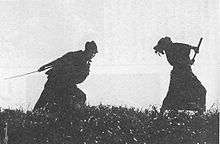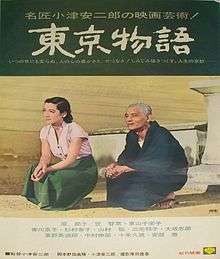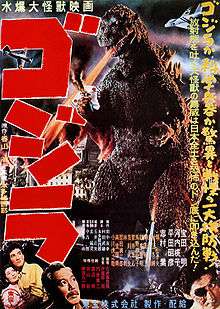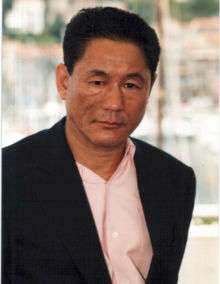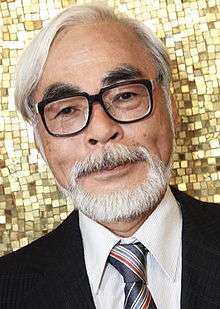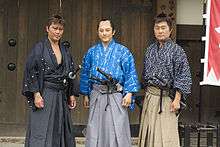Cinema of Japan
| Cinema of Japan | |
|---|---|
 Shingeki-kaikan (now cinema KOBE) in Kobe | |
| Number of screens | 3,437 (2015)[1] |
| • Per capita | 2.9 per 100,000 (2011)[2] |
| Main distributors |
Toho Co., Ltd. 32.6% Walt Disney Studios Japan 10.7% Toei Company, Ltd. 8.9%[3] |
| Number of admissions (2015)[1] | |
| Total | 166,630,000 |
| Gross box office (2015)[1] | |
| Total | ¥217.119 billion (US$1.8 billion)[4][1] |
| National films | ¥120.367 billion (55.4%)[1] |
The cinema of Japan (日本映画 Nihon eiga, also known domestically as 邦画 hōga, "domestic cinema") has a history that spans more than 100 years. Japan has one of the oldest and largest film industries in the world; as of 2010, it was the fourth largest by number of feature films produced.[5] In 2011 Japan produced 411 feature films that earned 54.9% of a box office total of US$2.338 billion.[6] Movies have been produced in Japan since 1897, when the first foreign cameramen arrived. In a Sight & Sound list of the best films produced in Asia, Japanese works made up eight of the top 12, with Tokyo Story (1953) ranked number one. Japan has won the Academy Award for the Best Foreign Language Film four times, once again more than any other Asian country.
History
Silent era
The kinetoscope, first shown commercially by Thomas Edison in the United States in 1894, was first shown in Japan in November 1896. The Vitascope and the Lumière Brothers' Cinematograph were first presented in Japan in early 1897,[7] by businessmen such as Inabata Katsutaro.[8] Lumière cameramen were the first to shoot films in Japan.[9] Moving pictures, however, were not an entirely new experience for the Japanese because of their rich tradition of pre-cinematic devices such as gentō (utsushi-e) or the magic lantern.[10][11] The first successful Japanese film in late 1897 showed sights in Tokyo.[12]
In 1898 some ghost films were made, the Shirō Asano shorts Bake Jizo (Jizo the Spook / 化け地蔵) and Shinin no sosei (Resurrection of a Corpse).[13] The first documentary, the short Geisha no teodori (芸者の手踊り), was made in June 1899. Tsunekichi Shibata made a number of early films, including Momijigari, an 1899 record of two famous actors performing a scene from a well-known kabuki play. Early films were influenced by traditional theater – for example, kabuki and bunraku.
At the dawn of the twentieth century theaters in Japan hired benshi, storytellers who sat next to the screen and narrated silent movies. They were descendants of kabuki jōruri, kōdan storytellers, theater barkers and other forms of oral storytelling.[14] Benshi could be accompanied by music like silent films from cinema of the West. With the advent of sound in the early 1930s, the benshi gradually disappeared.
In 1908, Shōzō Makino, considered the pioneering director of Japanese film, began his influential career with Honnōji gassen (本能寺合戦), produced for Yokota Shōkai. Shōzō recruited Matsunosuke Onoe, a former kabuki actor, to star in his productions. Onoe became Japan's first film star, appearing in over 1,000 films, mostly shorts, between 1909 and 1926. The pair pioneered the jidaigeki genre.[15] Tokihiko Okada was a popular romantic lead of the same era.
The first female Japanese performer to appear in a film professionally was the dancer/actress Tokuko Nagai Takagi, who appeared in four shorts for the American-based Thanhouser Company between 1911 and 1914.[16]
Among intellectuals, critiques of Japanese cinema grew in the 1910s and eventually developed into a movement that transformed Japanese film. Film criticism began with early film magazines such as Katsudō shashinkai (begun in 1909) and a full-length book written by Yasunosuke Gonda in 1914, but many early film critics often focused on chastising the work of studios like Nikkatsu and Tenkatsu for being too theatrical (using, for instance, elements from kabuki and shinpa such as onnagata) and for not utilizing what were considered more cinematic techniques to tell stories, instead relying on benshi. In what was later named the Pure Film Movement, writers in magazines such as Kinema Record called for a broader use of such cinematic techniques. Some of these critics, such as Norimasa Kaeriyama, went on to put their ideas into practice by directing such films as The Glow of Life (1918). There were parallel efforts elsewhere in the film industry. In his 1917 film The Captain's Daughter, Masao Inoue started using techniques new to the silent film era, such as the close-up and cut back. The Pure Film Movement was central in the development of the gendaigeki and scriptwriting.[17] New studios established around 1920, such as Shochiku and Taikatsu, aided the cause for reform. At Taikatsu, Thomas Kurihara directed films scripted by the novelist Junichiro Tanizaki, who was a strong advocate of film reform.[18] Even Nikkatsu produced reformist films under the direction of Eizō Tanaka. By the mid-1920s, actresses had replaced onnagata and films used more of the devices pioneered by Inoue. Some of the most discussed silent films from Japan are those of Kenji Mizoguchi, whose later works (e.g., The Life of Oharu) are still highly regarded.
Japanese films gained popularity in the mid-1920s against foreign films, in part fueled by the popularity of movie stars and a new style of jidaigeki. Directors such as Daisuke Itō and Masahiro Makino made samurai films like A Diary of Chuji's Travels and Roningai featuring rebellious antiheroes in fast-cut fight scenes that were both critically acclaimed and commercial successes.[19] Some stars, such as Tsumasaburo Bando, Kanjūrō Arashi, Chiezō Kataoka, Takako Irie and Utaemon Ichikawa, were inspired by Makino Film Productions and formed their own independent production companies where directors such as Hiroshi Inagaki, Mansaku Itami and Sadao Yamanaka honed their skills. Director Teinosuke Kinugasa created a production company to produce the experimental masterpiece A Page of Madness, starring Masao Inoue, in 1926.[20] Many of these companies, while surviving during the silent era against major studios like Nikkatsu, Shochiku, Teikine, and Toa Studios, could not survive the cost involved in converting to sound.
With the rise of left-wing political movements and labor unions at the end of the 1920s arose so-called tendency films with left-wing "tendencies", with prominent examples being directed by Kenji Mizoguchi, Daisuke Itō, Shigeyoshi Suzuki, and Tomu Uchida. In contrast with these commercially produced 35 mm films, the Marxist Proletarian Film League of Japan (Prokino) made works independently in smaller gauges (such as 9.5mm and 16mm), with more radical intentions.[21] Tendency films suffered from severe censorship heading into the 1930s, and Prokino members were arrested and the movement effectively crushed. Such moves by the government had profound effects on the expression of political dissent in 1930s cinema. Films from this period include: Sakanaya Honda, Jitsuroku Chushingura, Horaijima, Orochi, Maboroshi, Kurutta Ippeji, Jujiro, Kurama Tengu: Kyōfu Jidai, and Kurama Tengu.[22]
A later version of The Captain's Daughter was one of the first talkie films. It used the Mina Talkie System. The Japanese film industry later split into two groups; one retained the Mina Talkie System, while the other used the Iisutofyon Talkie System used to make Tojo Masaki's films.
The 1923 earthquake, the bombing of Tokyo during World War II, and the natural effects of time and Japan's humidity on inflammable and unstable nitrate film have resulted in a great dearth of surviving films from this period.
1930s
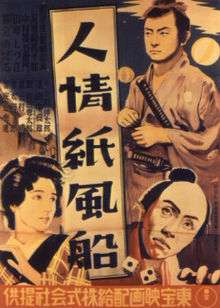
Unlike in the West, silent films were still being produced in Japan well into the 1930s. A few Japanese sound shorts were made in the 1920s and 1930s, but Japan's first feature-length talkie was Fujiwara Yoshie no furusato (1930), which used the Mina Talkie System. Notable talkies of this period include Mikio Naruse's Wife, Be Like A Rose! (Tsuma Yo Bara No Yoni, 1935), which was one of the first Japanese films to gain a theatrical release in the U.S.; Yasujirō Ozu's An Inn in Tokyo, considered a precursor to the neorealism genre; Kenji Mizoguchi's Sisters of the Gion (Gion no shimai, 1936); Osaka Elegy (1936); and The Story of the Last Chrysanthemums (1939); and Sadao Yamanaka's Humanity and Paper Balloons (1937).
The 1930s also saw increased government involvement in cinema, which was symbolized by the passing of the Film Law, which gave the state more authority over the film industry, in 1939. The government encouraged some forms of cinema, producing propaganda films and promoting documentary films (also called bunka eiga or "culture films"), with important documentaries being made by directors such as Fumio Kamei.[23] Realism was in favor; film theorists such as Taihei Imamura advocated for documentary, while directors such as Hiroshi Shimizu and Tomotaka Tasaka produced fiction films that were strongly realistic in style.
1940s
Because of World War II and the weak economy, unemployment became widespread in Japan, and the cinema industry suffered.
During this period, when Japan was expanding its Empire, the Japanese government saw cinema as a propaganda tool to show the glory and invincibility of the Empire of Japan. Thus, many films from this period depict patriotic and militaristic themes. In 1942 Kajiro Yamamoto's film Hawai Mare oki kaisen or "The War at Sea from Hawaii to Malaya" portrayed the attack on Pearl Harbor; the film made use of special effects directed by Eiji Tsuburaya, including a miniature scale model of Pearl Harbor itself.
Akira Kurosawa made his feature film debut with Sugata Sanshiro in 1943. The first collaborations between Kurosawa and actor Toshiro Mifune were Drunken Angel in 1948 and Stray Dog in 1949. Yasujirō Ozu directed the critically and commercially successful Late Spring in 1949.
The Mainichi Film Award was created in 1946.[24]
With the SCAP occupation following the end of World War II, Japan was exposed to over a decade's worth of American animation that had been banned under the war-time government.
1950s
The 1950s were the Golden Age of Japanese Cinema.[25] Three Japanese films from this decade (Rashomon, Seven Samurai and Tokyo Story) made the Sight & Sound's 2002 Critics and Directors Poll for the best films of all time.[26] The period after the American Occupation led to a rise in diversity in movie distribution thanks to the increased output and popularity of the film studios of Toho, Daiei, Shochiku, Nikkatsu, and Toei. This period gave rise to the four great artists of Japanese cinema: Masaki Kobayashi, Akira Kurosawa, Kenji Mizoguchi, and Yasujirō Ozu. Each director dealt with the effects the war and subsequent occupation by America in unique and innovative ways.
The decade started with Akira Kurosawa's Rashomon (1950), which won the Golden Lion at the Venice Film Festival in 1951 and the Academy Award for Best Foreign Language Film in 1952, and marked the entrance of Japanese cinema onto the world stage. It was also the breakout role for legendary star Toshiro Mifune.[27] In 1953 Entotsu no mieru basho by Heinosuke Gosho was in competition at the 3rd Berlin International Film Festival.
The first Japanese film in color was Carmen Comes Home directed by Keisuke Kinoshita and released in 1951. There was also a black-and-white version of this film available. Tokyo File 212 (1951) was the first American feature film to be shot entirely in Japan. The lead roles were played by Florence Marly and Robert Peyton. It featured the geisha Ichimaru in a short cameo. Suzuki Ikuzo's Tonichi Enterprises Company co-produced the film.[28] Gate of Hell, a 1953 film by Teinosuke Kinugasa, was the first movie that filmed using Eastmancolor film, Gate of Hell was both Daiei's first color film and the first Japanese color movie to be released outside Japan, receiving an Oscar in 1954 for Best Costume Design by Sanzo Wada and an Honorary Award for Best Foreign Language Film. It also won the Palme d'Or at the Cannes Film Festival, the first Japanese film to achieve that honour.
The year 1954 saw two of Japan's most influential films released. The first was the Kurosawa epic Seven Samurai, about a band of hired samurai who protect a helpless village from a rapacious gang of thieves. The same year, Ishirō Honda directed the anti-nuclear monster-drama Godzilla, which was released in America as Godzilla, King of the Monsters. Though edited for its Western release, Godzilla became an international icon of Japan and spawned an entire subgenre of kaiju films. Also in 1954, both another Kurosawa film, Ikiru, and Yasujirō Ozu's Tokyo Story were in competition at the 4th Berlin International Film Festival.
In 1955, Hiroshi Inagaki won an Academy Award for Best Foreign Language Film for Part I of his Samurai trilogy and in 1958 won the Golden Lion at the Venice Film Festival for Rickshaw Man. Kon Ichikawa directed two anti-war dramas: The Burmese Harp (1956), which was nominated for Best Foreign Language Film at the Academy Awards, and Fires On The Plain (1959), along with Enjo (1958), which was adapted from Yukio Mishima's novel Temple Of The Golden Pavilion. Masaki Kobayashi made three films which would collectively become known as The Human Condition Trilogy: No Greater Love (1959), and The Road To Eternity (1959). The trilogy was completed in 1961, with A Soldier's Prayer.
Kenji Mizoguchi, who died in 1956, ended his career with a series of masterpieces including The Life of Oharu (1952), Ugetsu (1953) and Sansho the Bailiff (1954). He won the Silver Bear at the Venice Film Festival for Ugetsu. Mizoguchi's films often deal with the tragedies inflicted on women by Japanese society. Mikio Naruse made Repast (1950), Late Chrysanthemums (1954), The Sound of the Mountain (1954) and Floating Clouds (1955). Yasujirō Ozu began directing color films beginning with Equinox Flower (1958), and later Good Morning (1959) and Floating Weeds (1958), which was adapted from his earlier silent A Story of Floating Weeds (1934), and was shot by Rashomon and Sansho the Bailiff cinematographer Kazuo Miyagawa.
The Blue Ribbon Awards were established in 1950. The first winner for Best Film was Until We Meet Again by Tadashi Imai.
1960s
The number of films produced, and the cinema audience reached a peak in the 1960s. Most films were shown in double bills, with one half of the bill being a "program picture" or B-movie. A typical program picture was shot in four weeks. The demand for these program pictures in quantity meant the growth of film series such as The Hoodlum Soldier or Akumyo.
The huge level of activity of 1960s Japanese cinema also resulted in many classics. Akira Kurosawa directed the 1961 classic Yojimbo. Yasujirō Ozu made his final film, An Autumn Afternoon, in 1962. Mikio Naruse directed the wide screen melodrama When a Woman Ascends the Stairs in 1960; his final film was 1967's Scattered Clouds.
Kon Ichikawa captured the watershed 1964 Olympics in his three-hour documentary Tokyo Olympiad (1965). Seijun Suzuki was fired by Nikkatsu for "making films that don't make any sense and don't make any money" after his surrealist yakuza flick Branded to Kill (1967).
The 1960s were the peak years of the Japanese New Wave movement, which began in the 1950s and continued through the early 1970s. Nagisa Oshima, Kaneto Shindo, Masahiro Shinoda, Susumu Hani and Shohei Imamura emerged as major filmmakers during the decade. Oshima's Cruel Story of Youth, Night and Fog in Japan and Death By Hanging, along with Shindo's Onibaba, Hani's Kanojo to kare and Imamura's The Insect Woman, became some of the better-known examples of Japanese New Wave filmmaking. Documentary played a crucial role in the New Wave, as directors such as Hani, Kazuo Kuroki, Toshio Matsumoto, and Hiroshi Teshigahara moved from documentary into fiction film, while feature filmmakers like Oshima and Imamura also made documentaries. Shinsuke Ogawa and Noriaki Tsuchimoto became the most important documentarists: "two figures [that] tower over the landscape of Japanese documentary."[29]
Teshigahara's Woman in the Dunes (1964) won the Special Jury Prize at the Cannes Film Festival, and was nominated for Best Director and Best Foreign Language Film Oscars. Masaki Kobayashi's Kwaidan (1965) also picked up the Special Jury Prize at Cannes and received a nomination for Best Foreign Language Film at the Academy Awards. Bushido, Samurai Saga by Tadashi Imai won the Golden Bear at the 13th Berlin International Film Festival. Immortal Love by Keisuke Kinoshita and Twin Sisters of Kyoto and Portrait of Chieko, both by Noboru Nakamura, also received nominations for Best Foreign Language Film at the Academy Awards. Lost Spring, also by Nakamura, was in competition for the Golden Bear at the 17th Berlin International Film Festival.
1970s
The 1970s saw the cinema audience drop due to the spread of television. Total audience declined from 1.2 billion in 1960 to 0.2 billion in 1980.[30] Film companies fought back in various ways, such as the bigger budget films of Kadokawa Pictures, or including increasingly sexual or violent content and language which could not be shown on television. The resulting pink film industry became the stepping stone for many young independent filmmakers. The seventies also saw the start of the "idol eiga", films starring young "idols", who would bring in audiences due to their fame and popularity.
Toshiya Fujita made the revenge film Lady Snowblood in 1973. In the same year, Yoshishige Yoshida made the film Coup d'État, a portrait of Ikki Kita, the leader of the Japanese coup of February 1936. Its experimental cinematography and mise-en-scène, as well as its avant-garde score by Ichiyanagi Sei, garnered it wide critical acclaim within Japan.
In 1976 the Hochi Film Award was created. The first winner for Best Film was The Inugamis by Kon Ichikawa. Nagisa Oshima directed In the Realm of the Senses (1976), a film detailing a crime of passion involving Sada Abe set in the 1930s. Controversial for its explicit sexual content, it has never been seen uncensored in Japan.
Kinji Fukasaku completed the epic Battles Without Honor and Humanity series of yakuza films. Yoji Yamada introduced the commercially successful Tora-San series, while also directing other films, notably the popular The Yellow Handkerchief, which won the first Japan Academy Prize for Best Film in 1978. New wave filmmakers Susumu Hani and Shōhei Imamura retreated to documentary work, though Imamura made a dramatic return to feature filmmaking with Vengeance Is Mine (1979).
Dodes'ka-den by Akira Kurosawa and Sandakan No. 8 by Kei Kumai were nominated to the Academy Award for Best Foreign Language Film.
1980s
The 1980s saw the decline of the major Japanese film studios and their associated chains of cinemas, with major studios Toho and Toei barely staying in business, Shochiku supported almost solely by the Otoko wa tsurai films, and Nikkatsu declining even further.
Of the older generation of directors, Akira Kurosawa directed Kagemusha (1980), which won the Palme d'Or at the 1980 Cannes Film Festival, and Ran (1985). Seijun Suzuki made a comeback beginning with Zigeunerweisen in 1980. Shohei Imamura won the Palme d'Or at the Cannes Film Festival for The Ballad of Narayama (1983). Yoshishige Yoshida made A Promise (1986), his first film since 1973's Coup d'État.
New directors who appeared in the 80s include actor Juzo Itami, who directed his first film, The Funeral, in 1984, and achieved critical and box office success with Tampopo in 1985. Kiyoshi Kurosawa, who would generate international attention beginning in the mid-1990s, made his initial debut with pink films and genre horror.
During the 1980s, anime gained in popularity, with new animated movies released every summer and winter, often based upon popular anime television series. Mamoru Oshii released his landmark Angel's Egg in 1983. Hayao Miyazaki adapted his manga series Nausicaä of the Valley of Wind into a feature film of the same name in 1984. Katsuhiro Otomo followed suit by adapting his own manga Akira into a feature film of the same name in 1988.
Home video made possible the creation of a direct-to-video film industry.
1990s
Because of economic recessions, the number of movie theaters in Japan had been steadily decreasing since the 1960s. The 1990s saw the reversal of this trend and the introduction of the Multiplex in Japan.
Takeshi Kitano emerged as a significant filmmaker with works such as Sonatine (1993), Kids Return (1996) and Hana-bi (1997), which was given the Golden Lion at the Venice Film Festival. Shōhei Imamura again won the Golden Palm (shared with Iranian director Abbas Kiarostami), this time for The Eel (1997). He became the fourth two-time recipient, joining Alf Sjöberg, Francis Ford Coppola and Bille August.
Kiyoshi Kurosawa gained international recognition following the release of Kyua (1997). Takashi Miike launched a prolific career with titles such as Audition (1999), Dead or Alive (1999) and The Bird People in China (1998). Former documentary filmmaker Hirokazu Koreeda launched an acclaimed feature career with Maborosi (1996) and After Life (1999).
Hayao Miyazaki directed two mammoth box office and critical successes, Porco Rosso (1992) – which beat E.T. (1982) as the highest-grossing film in Japan – and Princess Mononoke (1997), which also claimed the top box office spot until Titanic (1997).
Several new anime directors rose to widespread recognition, bringing with them notions of anime as not only entertainment, but modern art. Mamoru Oshii released the internationally acclaimed philosophical science fiction action film Ghost in the Shell in 1996. Satoshi Kon directed the award-winning psychological thriller Perfect Blue. Hideaki Anno also gained considerable recognition with The End of Evangelion in 1997.
2000s
The number of movies being shown in Japan steadily increased, with about 821 films released in 2006. Movies based on Japanese television series were especially popular during this period. Anime films now accounted for 60 percent of Japanese film production. The 1990s and 2000s are considered to be "Japanese Cinema's Second Golden Age", due to the immense popularity of anime, both within Japan and overseas.[25]
Although not a commercial success, All About Lily Chou-Chou directed by Shunji Iwai was honored at the Berlin, the Yokohama and the Shanghai Film Festivals in 2001. Takeshi Kitano appeared in Battle Royale and directed and starred in Dolls and Zatoichi. Several horror films, Kairo, Dark Water, Yogen, the Grudge series and One Missed Call met with commercial success. In 2004, Godzilla: Final Wars, directed by Ryuhei Kitamura, was released to celebrate the 50th anniversary of Godzilla. In 2005, director Seijun Suzuki made his 56th film, Princess Raccoon. Hirokazu Koreeda claimed film festival awards around the world with two of his films Distance and Nobody Knows. Female film director Naomi Kawase's film The Mourning Forest won the Grand Prix at the Cannes Film Festival in 2007. Yoji Yamada, director of the Otoko wa Tsurai yo series, made a trilogy of acclaimed revisionist samurai films, 2002's Twilight Samurai, followed by The Hidden Blade in 2004 and Love and Honor in 2006.
In anime, Hayao Miyazaki directed Spirited Away in 2001, breaking Japanese box office records and winning several awards, followed by Howl's Moving Castle and Ponyo in 2004 and 2008 respectively. In 2004, Mamoru Oshii released the anime movie Ghost in the Shell 2: Innocence which received critical praise around the world. His 2008 film The Sky Crawlers was met with similarly positive international reception. Satoshi Kon also released three quieter, but nonetheless highly successful films: Millennium Actress, Tokyo Godfathers, and Paprika. Katsuhiro Otomo released Steamboy, his first animated project since the 1995 short film compilation Memories, in 2004. In collaboration with Studio 4C, American director Michael Arias released Tekkon Kinkreet in 2008, to international acclaim. After several years of directing primarily lower-key live-action films, Hideaki Anno formed his own production studio and revisited his still-popular Evangelion franchise with the Rebuild of Evangelion tetralogy, a new series of films providing an alternate retelling of the original story.
In February 2000, the Japan Film Commission Promotion Council was established. On November 16, 2001, the Japanese Foundation for the Promotion of the Arts laws were presented to the House of Representatives. These laws were intended to promote the production of media arts, including film scenery, and stipulate that the government – on both the national and local levels – must lend aid in order to preserve film media. The laws were passed on November 30 and came into effect on December 7. In 2003, at a gathering for the Agency of Cultural Affairs, twelve policies were proposed in a written report to allow public-made films to be promoted and shown at the Film Center of the National Museum of Modern Art.
2010s
Four films have so far received international recognition by being selected to compete in major film festivals: Caterpillar by Kōji Wakamatsu was in competition for the Golden Bear at the 60th Berlin International Film Festival and won the Silver Bear for Best Actress, Outrage by Takeshi Kitano was In Competition for the Palme d'Or at the 2010 Cannes Film Festival, Himizu by Sion Sono was in competition for the Golden Lion at the 68th Venice International Film Festival.
In 2011, Takashi Miike's Hara-Kiri: Death of a Samurai was In Competition for the Palme d'Or at the 2012 Cannes Film Festival, the first 3D film ever to screen In Competition at Cannes. The film was co-produced by British independent producer Jeremy Thomas, who had successfully broken Japanese titles such as Nagisa Oshima's Merry Christmas, Mr Lawrence and Taboo, Takeshi Kitano's Brother, and Miike's 13 Assassins onto the international stage as producer.
Genres
Genres of Japanese film include:
- Jidaigeki: period pieces set during the Edo period (1603–1868) or earlier.
- Samurai cinema, a subgenre of jidaigeki, also known as chambara (onomatopoeia describing the sound of swords clashing).
- Horror: horror films such as Ring
- Tokusatsu
- Pink films: softcore pornographic films.
- Yakuza films: films about Yakuza mobsters.
- Gendaigeki: the opposite of "jidaigeki", films set in the present day.
- Shomingeki: realistic films about common working people
- Anime: Animation. Anime refers to "Japanese animation" in English.
- Science fiction
Box office
| Year | Gross (in billions of yen) | Domestic share | Admissions (in millions) | Source(s) |
|---|---|---|---|---|
| 2009 | 206 | 57% | 169 | [31] |
| 2010 | 221 | 54% | 174 | [31] |
| 2011 | 181 | 55% | 144.73 | [32][33] |
| 2012 | 195.2 | 65.7% | 155.16 | [33][34] |
| 2013 | 194 | 60.6% | 156 | [35][36] |
| 2014 | 207 | 58% | 161 | [37][38] |
| 2015 | 217.119 | 55.4% | 166.63 | [1] |
See also
- Cinema of the world
- History of cinema
- Japan Academy Prize
- List of Japanese actors
- List of Japanese actresses
- List of Japanese film directors
- List of Japanese films
- List of Japanese-language films
- List of Japanese movie studios
- Nuberu bagu (The Japanese New Wave)
- List of Japanese submissions for the Academy Award for Best Foreign Language Film
- Television in Japan
- Voice acting in Japan
References
- 1 2 3 4 5 6 "Statistics of Film Industry in Japan". Motion Picture Producers Association of Japan. Retrieved 12 September 2016.
- ↑ "Table 8: Cinema Infrastructure - Capacity". UNESCO Institute for Statistics. Retrieved 5 November 2013.
- ↑ "Table 6: Share of Top 3 distributors (Excel)". UNESCO Institute for Statistics. Retrieved 5 November 2013.
- ↑ Frater, Patrick (April 13, 2016). "Asia Expands Domination of Global Box Office". Variety. Retrieved April 19, 2016.
- ↑ "Top 50 countries ranked by number of feature films produced, 2005–2010". Screen Australia. Archived from the original on October 27, 2012. Retrieved 2012-07-14.
- ↑ "Japanese Box Office Sales Fall 18% in 2011". Anime News Network. 2012-01-26. Retrieved 2012-01-28.
- ↑ Tsukada, Yoshinobu (1980). Nihon eigashi no kenkyū: katsudō shashin torai zengo no jijō. Gendai Shokan.
- ↑ McKernan, Luke. "Inabata Katsutaro". Who's Who of Victorian Cinema. Retrieved 14 December 2012.
- ↑ Yoshishige Yoshida; Masao Yamaguchi; Naoyuki Kinoshita (eds.). Eiga denrai: shinematogurafu to <Meiji no Nihon>. 1995: Iwanami Shoten. ISBN 4-00-000210-4.
- ↑ Iwamoto, Kenji (2002). Gentō no seiki: eiga zenʾya no shikaku bunkashi = Centuries of magic lanterns in Japan. Shinwasha. ISBN 978-4-916087-25-6.
- ↑ Kusahara, Machiko (1999). "Utushi-e (Japanese Phantasmagoria)". Media Art Plaza. Retrieved 29 December 2009.
- ↑ Keiko I. McDonald (2006). Reading a Japanese Film: Cinema in Context. University of Hawaii Press. ISBN 978-0-8248-2993-3.
- ↑ Seek Japan | J-Horror: An Alternative Guide Archived August 24, 2011, at WebCite
- ↑ Dym, Jeffrey A. (2003). Benshi, Japanese Silent Film Narrators, and Their Forgotten Narrative Art of Setsumei: A History of Japanese Silent Film Narration. Edwin Mellen Press. ISBN 978-0-7734-6648-7.
- ↑ "Who's Who in Japanese Silent Films". Matsuda Film Productions. Retrieved 2007-01-05.
- ↑ Cohen, Aaron M. "Tokuko Nagai Takaki: Japan's First Film Actress". Bright Lights Film Journal 30 (October 2000). Retrieved 2007-01-05.
- ↑ See Bernardi.
- ↑ See Lamarre.
- ↑ Thornton, S. A. (2008). The Japanese Period Film. McFarland & Co. ISBN 978-0-7864-3136-6.
- ↑ See Gerow, A Page of Madness.
- ↑ Nornes, Japanese Documentary Film, pp. 19–47.
- ↑ Japanese films of the 1920s
- ↑ See Nornes, Japanese Documentary Film.
- ↑ 毎日映画コンクールとは (in Japanese). mainichi.jp.
- 1 2 Dave Kehr, Anime, Japanese Cinema's Second Golden Age, The New York Times, January 20, 2002.
- ↑ BFI | Sight & Sound | Top Ten Poll 2002
- ↑ Prince, Stephen (1999). The Warrior's Camera. Princeton University Press. ISBN 978-0-691-01046-5., p.127.
- ↑ "Tokyo File 212: Detail View". American Film Institute.
- ↑ Nornes, Abé Mark (2011). "Noriaki Tsuchimoto and the Reverse View Documentary". The Documentaries of Noriaki Tsuchimoto. Zakka Films. pp. 2–4.
- ↑ Sato, Tadao (1982). Currents in Japanese Cinema. Kodansha. p. 244.
- 1 2 Patrick Frater (January 28, 2011). "Japanese box office climbs 7% in 2010". Film Business Asia. Retrieved April 12, 2015.
- ↑ Patrick Frater (January 27, 2012). "Japanese BO plunges by 18%". Film Business Asia. Retrieved April 12, 2015.
- 1 2 Jason Gray (January 30, 2013). "Japanese box office up 7.7%". screendaily.com. Retrieved April 12, 2015.
- ↑ Mark Schilling (January 30, 2013). "Japanese B.O. rises 7.7% to $2.14 bil". variety.com. Retrieved April 12, 2015.
- ↑ Kevin Ma (29 January 2014). "Japan B.O. down 0.5% in 2013". Film Business Asia. Archived from the original on 3 March 2016. Retrieved 30 January 2014.
- ↑ Gavin J. Blair (January 28, 2014). "Japan Box Office Drops Slightly in 2013". hollywoodreporter.com. Retrieved April 12, 2015.
- ↑ Gavin J. Blair (January 26, 2015). "Japan's Box Office Up 6.6 Percent to $1.75 billion in 2014". hollywoodreporter.com. Retrieved April 12, 2015.
- ↑ Mark Schilling (January 27, 2015). "Japan Box Office in 2014 is Third Biggest of 21st Century". variety.com. Retrieved April 12, 2015.
Bibliography
- Anderson, Joseph L.; Donald Richie (1982). The Japanese Film: Art and Industry (Expanded ed.). Princeton University Press. ISBN 978-0-691-00792-2.
- Baskett, Michael (2008). The Attractive Empire: Transnational Film Culture in Imperial Japan. Honolulu: University of Hawai'i Press. ISBN 978-0-8248-3223-0.
- 無声映画鑑賞会 (2001). The Benshi-Japanese Silent Film Narrators. Tokyo: Urban Connections. ISBN 978-4-900849-51-8.
- Bernardi, Joanne (2001). Writing in Light: The Silent Scenario and the Japanese Pure Film Movement. Wayne State University Press. ISBN 978-0-8143-2926-9.
- Bock, Audie (1978). Japanese Film Directors. Kodansha. ISBN 0-87011-304-6.
- Bordwell, David (1988). Ozu and the Poetics of Cinema. Princeton University Press. ISBN 978-0-691-00822-6. Available online at the Center for Japanese Studies, University of Michigan
- Bowyer, Justin, ed. (2004). The Cinema of Japan and Korea. Wallflower Press, London. ISBN 978-1-904764-11-3.
- Burch, Nöel (1979). To the Distant Observer: Form and Meaning in the Japanese Cinema. University of California Press. ISBN 978-0-520-03605-5. Available online at the Center for Japanese Studies, University of Michigan
- Cazdyn, Eric (2002). The Flash of Capital: Film and Geopolitics in Japan. Duke University Press. ISBN 978-0-8223-2912-1.
- Desser, David (1988). Eros Plus Massacre: An Introduction to the Japanese New Wave Cinema. Indiana University Press. ISBN 978-0-253-20469-1.
- Dym, Jeffrey A. (2003). Benshi, Japanese Silent Film Narrators, and Their Forgotten Narrative Art of Setsumei: A History of Japanese Silent Film Narration. Edwin Mellen Press. ISBN 978-0-7734-6648-7. (review)
- Furuhata, Yuriko (2013). Cinema of Actuality: Japanese Avant-garde Filmmaking in the Season of Image Politics. Duke University Press. ISBN 9780822354901.
- Gerow, Aaron (2008). A Page of Madness: Cinema and Modernity in 1920s Japan. Center for Japanese Studies, University of Michigan. ISBN 978-1-929280-51-3.
- Gerow, Aaron (2010). Visions of Japanese Modernity: Articulations of Cinema, Nation, and Spectatorship, 1895–1925. University of California Press. ISBN 978-0-520-25456-5.
- High, Peter B. (2003). The Imperial Screen. Wisconsin Studies in Film. The University of Wisconsin Press. ISBN 0-299-18134-0.
- Hirano, Kyoko (1992). Mr. Smith Goes to Tokyo: The Japanese Cinema under the Occupation, 1945–1952. Smithsonian Institution. ISBN 978-1-56098-157-2.
- Lamarre, Thomas (2005). Shadows on the Screen: Tanizaki Junʾichirō on Cinema and "Oriental" Aesthetics. Center for Japanese Studies, University of Michigan. ISBN 978-1-929280-32-2.
- Mellen, Joan (1976). The Waves At Genji's Door: Japan Through Its Cinema. Pantheon, New York. ISBN 978-0-394-49799-0.
- Nolletti, Jr., Arthur; Desser, David, eds. (1992). Reframing Japanese Cinema: Authorship, Genre, History. Indiana University Press. ISBN 978-0-253-34108-2.
- Nornes, Abé Mark (2003). Japanese Documentary Film: The Meiji Era through Hiroshima. Minneapolis: University of Minnesota Press. ISBN 978-0-8166-4045-4.
- Nornes, Abé Mark (2007). Forest of Pressure: Ogawa Shinsuke and Postwar Japanese Documentary. Minneapolis: University of Minnesota Press. ISBN 978-0-8166-4908-2.
- Nornes, Abé Mark; Gerow, Aaron (2009). Research Guide to Japanese Film Studies. Center for Japanese Studies, University of Michigan. ISBN 978-1-929280-53-7.
- Prince, Stephen (1999). The Warrior's Camera. Princeton University Press. ISBN 978-0-691-01046-5.
- Richie, Donald (2005). A Hundred Years of Japanese Film: A Concise History, with a Selective Guide to DVDs and Videos. Kodansha America. ISBN 978-4-7700-2995-9.
- Sato, Tadao (1982). Currents In Japanese Cinema. Kodansha America. ISBN 978-0-87011-815-9.
- Wada-Marciano, Mitsuyo (2008). Nippon Modern: Japanese Cinema of the 1920s and 1930s. University of Hawaii Press. ISBN 978-0-8248-3240-7.
External links
| Look up Appendix:Japanese film credit terms in Wiktionary, the free dictionary. |
- Chronology of Japanese Cinema by Joaquín da Silva
- Toki Akihiro & Mizuguchi Kaoru (1996) A History of Early Cinema in Kyoto, Japan (1896–1912). Cinematographe and Inabata Katsutaro.
- Kato Mikiro (1996) A History of Movie Theaters and Audiences in Postwar Kyoto, the Capital of Japanese Cinema.
- Japanese Cinema Database, maintained by the Agency for Cultural Affairs (films after 1896, in Japanese)
- Japanese Film Database, maintained by UniJapan (in English, films after 2002)
- Kinema Junpo Database, maintained by Kinema Junpo (films after 1945, in Japanese)
- National Film Center Database (films in the national archive collection, in Japanese)
- Motion Picture Producers Association of Japan (includes film database, box office statistics)
- Japanese Movie Database (in Japanese)
- JAPAN CUTS: Festival of New Japanese Film (Japan Society, New York)
- Kinema Club
- Midnight Eye
- Japanese Reference Materials for Studying Japanese Cinema at Yale University by Aaron Gerow
- Japanese Cinema to 1960 by Gregg Rickman
- Japanese Film Festival (Singapore) – An annual curated film program focusing on classic Japanese cinema and new currents, with regular guest directors and actors.

